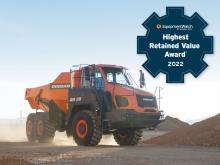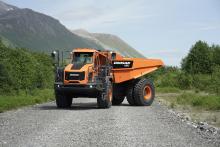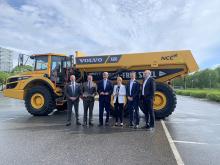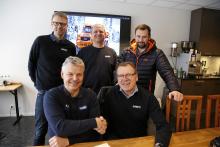
Production began at the plant in 1972 when the business was called Glamox. Since then, the brand has had several names, such as Moxy, Moxy Industrial, Brown Engineering, Moxy Trucks, and Moxy Engineering. In 2008, the name changed to Doosan when the South Korean manufacturer bought the factory and the product. In 2021, Hyundai Heavy Industries bought the Doosan construction equipment range, including the ADT line, and the name of the business was changed to Hyundai Doosan Infracore (HDI).
There are currently 150 employees at the Elnesvågen plant. With both Doosan and Hyundai ADTs now being produced at the factory, the workforce is expected to expand to meet an expected 40% growth in production.
The Doosan ADT range comprises two 6x6 models - the DA30-7 and DA45-7 Stage V compliant machines - the DA30-7 has a payload of 28 tonnes, while that of the DA45-7 is 41 tonnes. The range was extended at bauma 2022 Munich with the launch of a new 4x4 version of the DA45-7 ADT, intended to compete with rigid dump trucks (RDTs) in the 40-tonne class.
Like all Doosan ADTs, the DA30-7 and DA45-7 models feature an articulation hinge positioned behind the turning ring to provide equal weight distribution to the front axle even during maximum steer articulation. This combined with a free-swinging rear tandem bogie ensures equal distribution of weight to each wheel and guarantees permanent 6-wheel contact and drive for equal power distribution and excellent performance, particularly on difficult terrains such as soft ground, uneven surfaces, very steep slopes, tight turns or a combination of all of these difficult conditions.
Collectively, the forward turning point, the unique tandem bogie and the sloping rear frame result in ‘best in class’ rough and soft terrain capabilities. The unique body shape and sloping frame ensure equal load distribution on all the wheels making these machines the best haulers for soft terrain work. The design of the articulation also provides equal load distribution on the wheels on both the left and right-hand sides when turning, which is very important for the traction and stability of the machines. These outstanding features are available on the Doosan Stage V DA30-7 and DA45-7 ADT models.

In the new 4x4 ADT, the front truck and cab unit is the same as in the original 6x6 model, with modifications being made on the rear dumper unit only. Featuring a ZF EP8-420 transmission, the 4x4 DA45-7 is a two-axle ADT with twin wheels at the rear and a dumper section similar to that on RDTs in the 40-tonne class.
“With superior operation on poorer roads, smoother surfaces and steeper terrain, the aim of our new 4x4 machine is to challenge RDTs in the 40-tonne class by providing a dumper product that delivers much more than RDTs,” says Beka Nemstsveridze, ADT Product Manager at Doosan.
As well as performing better in conditions that are tough for RDTs, the new 4x4 DA45-7 ADT has a width of less than 4 m to avoid the need for special transportation and offers a better-turning radius than a comparable RDT. The shorter turning radius and the design of the rear dumper unit, which is more suited to carrying flat and heavy rocks, provide particular advantages in the mining and tunnelling industries.
The latter are growing markets for ADTs, and include pioneering, short-term mining projects, quarrying and contract mining industries, especially those in southern Africa, the UK and Australia. Construction and bulk earthmoving contractors involved in roads, dams, airports, landfills and development projects are also large users of ADTs. Together, these areas make the ADT market wide and varied, thereby ensuring a large customer base.










